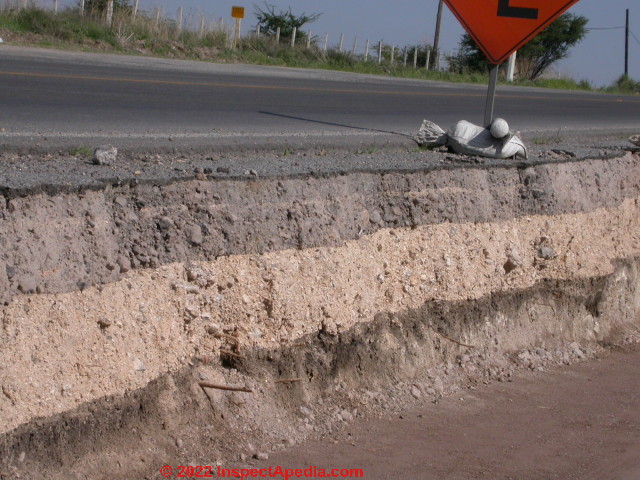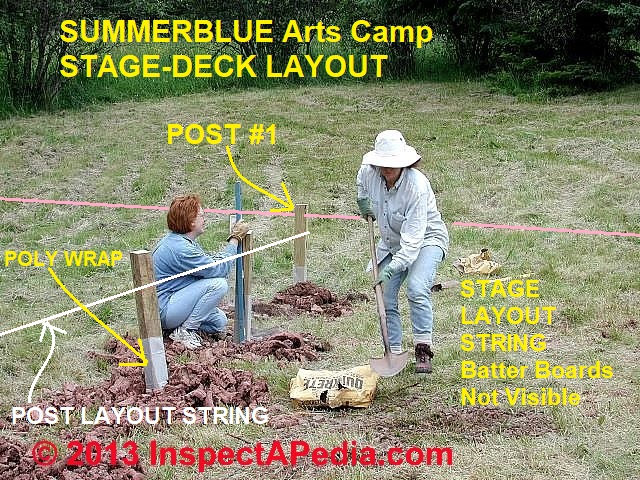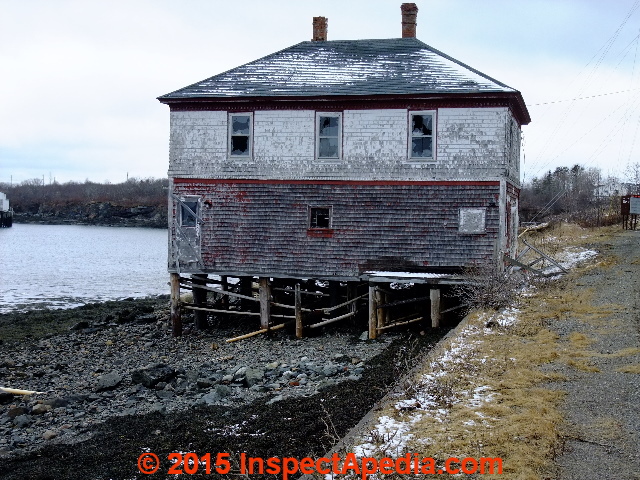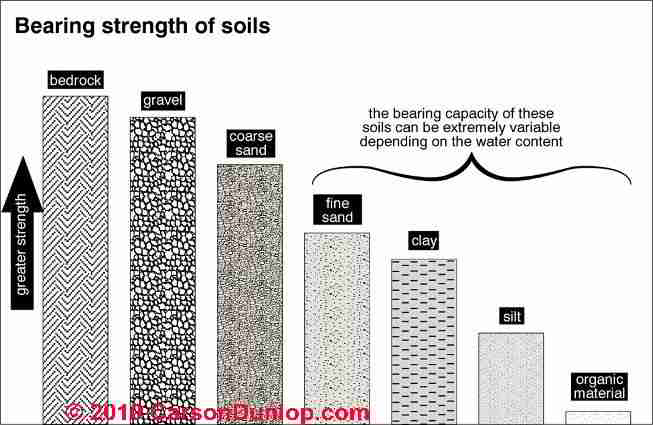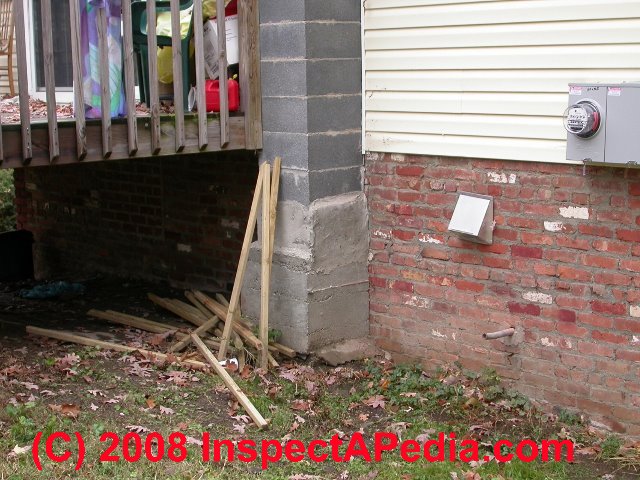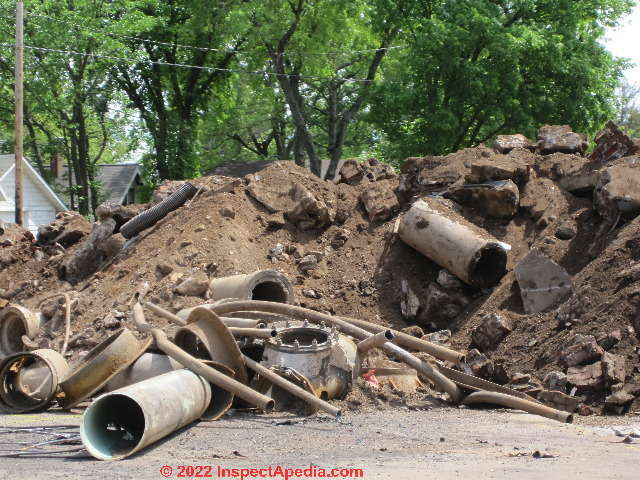 Soil Properties vs Building Failures
Soil Properties vs Building Failures
Examples of the effect of various soils on buildings
- POST a QUESTION or COMMENT about how different types of soil and soil backfill, compaction, or preparation effect buildings
This article describes the properties of the earth, soil, or backfill upon which buildings and building mechanical systems like septic tanks or fields are constructed.
We explain how certain soil conditions contribute to building failures such as settlement, foundation damage, water entry, well or septic problems or other concerns.
Construction on uncompacted fill can cause damage like that shown in the photo above. But we don't know the true cause of the damage shown without further investigation. Severe settlement and bulging in a concrete block foundation wall could be caused by footing settlement, frost heaves, or by the combined pressure of water and soil backfilled against that wall.
InspectAPedia tolerates no conflicts of interest. We have no relationship with advertisers, products, or services discussed at this website.
- Daniel Friedman, Publisher/Editor/Author - See WHO ARE WE?
 Impact of Soil Types, Preparation, Backfill on Buildings
Impact of Soil Types, Preparation, Backfill on Buildings
Illustration: the USDA Map of dominant soil types in the U.S. - using the USDA/NRCS soil type taxonomy that we introduce but do not use in this article. (Cited in detail below).
Most research on the effects of different soil types on buildings has focused on building resistance to earthquake damage or design of buildings to resist damage when constructed on expansive clay soil.
Here we focus on the more immediate and practical effects of different types of soil and terrain shapes on buildings, including building foundation settlement, cracking, or heaving and on septic systems, septic tanks, drainfields, and on water wells.
We include as well, warnings about constructing buildings or septic systems in areas where sinkholes are common.
Article Contents
- BASIC CLASSES of SOIL
- 7 SOIL TYPES to IDENTIFY at a BUILDING SITE
- EFFECTS of SOIL TYPE on STRUCTURES
- SOIL QUESTIONS WHEN BUYING PROPERTY
- EFFECTS of SOIL TYPE on BUILDING WATER ENTRY
- EFFECTS of SOIL TYPE on SEPTIC SYSTEMS
- EFFECTS of SOIL TYPE on WATER WELLS
- 12 SOIL TAXONOMIC ORDERS
- RESEARCH on SOIL PROPERTIES & EFFECTS
Basic Classes of Soil
Photo: layers of soil of different exposed by excavation during highway construction, Dolores, Mexico. Engineered fill, defined below, will commonly be found beneath roadways.
Engineers classify soils in North America and in many other areas as belonging to one of the following general groups of natural soils and fill soils.
Natural soils
- Coarse-grained soils: sand and gravel
- Fine-grained soils: clay and/or silt
- High-organic soils: peat or bog
These are three most-general classes of soil that you might find at a building site. Below we expand these into more-detailed soil groups whose properties must be considered when you are planning to build on a given site.
Fill soils & Fill Soil Types
These types of soil fill are used when fill is necessary at a building site in order to level a grade or to reach a desired elevation. All of these are considered "manmade" fills that in turn will be made up a mix of one or more of the natural soils listed above.
- Engineered fill:
soil or soil and aggregate materials has been designed for the specific construction needs and has been "placed" and usually compacted under the supervision of an engineer. Compaction requirements vary depending on what building and weight the soil has to support.
Properly engineered and placed soil helps guard against later subsidence, movement, and damage to a building whose foundation has been built in or on the fill.
The engineered fill soil may be obtained on-site or off-site but has been inspected, prepared, and placed under expert supervision to meet the needs of the building it must support. Depending on the need, the fill may be a mix of soil, crushed stone, gravel or other materials.
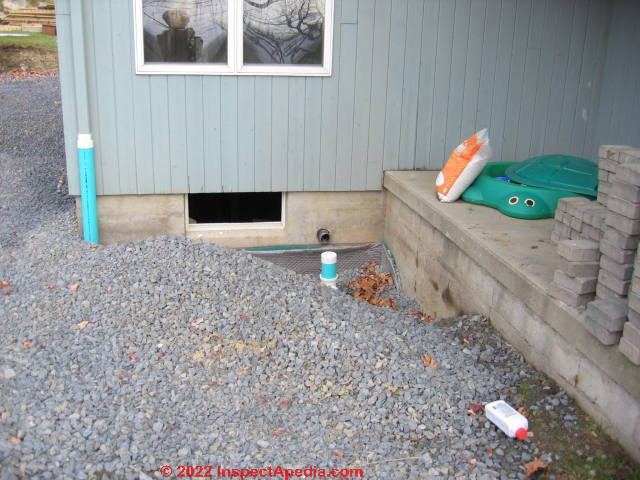
Photo above: the gravel fill at this building was specified by the site engineer.
- Hydraulic Fill:
soil or a mix of soil and gravel or other material is placed using a stream of water to combine the forces of water velocity and gravity to place and compact the fill where needed. Hydraulic fill may be used in the construction of a dam or dyke but would not commonly be used in building construction. - Undocumented Fill:
an undocumented, or uncertified fill is a mix of soils and/or other materials at a site to adjust grade, slope, or elevation without any documentation of the quality, density, or even method of placement of the material.
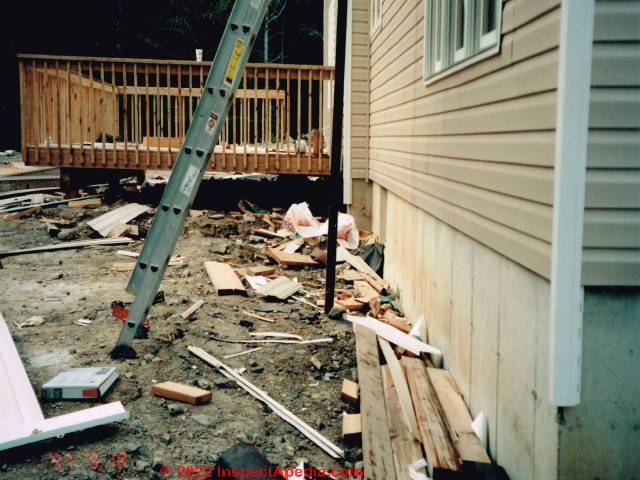
Photo above: the builder at this jobsite is using the foundation excavation as his trash dump, saving the cost of waste disposal but perhaps contributing to future water entry in the building, settlement around the foundation, and perhaps increased risk of insect attack.
Watch out: if your building site contains undocumented fill then further investigation by a geotechnical engineer may be needed before building on the site, lest your structure be damaged by settlement or movement or you discover unanticipated cost to deal with buried debris or other waste. .
...
7 Types of Soil to Identify at a Building Site
Here is a more-descriptive list of seven common types of soil that can and should be identified when you are buying property or considering building at a specific site. These are practical soil type definitions.
- Chalky soil,
for example, common in the UK, is an alkaline limestone, built up of very fine particles. Using the UK as an example, chalky soils can vary from a limestone clay consistency to a stony rocky mix, made up largely of calcium carbonate CaCO3, and are alkaline, with a pH between 7.1 and 8.0, usually making the chalky soil poor at holding nutrients poor in support of plant growth.
Chalk does not hold water, does not shrink or expand as moisture levels vary, and is generally a sound surface for building construction. A simple test for chalky soil is to shake a soil sample in a jar of vinegar. If the liquid turns frothy and foamy the soil sample is high in chalk or limestone.
- Clay soil
is comprised of extremely-fine soil particles that are densely packed, generally difficult to excavate, not absorbing water. Clay soil that is wet will feel quite sticky but when dry is incredibly hard and difficult to excavate. It contains little air and drains poorly.
Clay soil will be low in organic matter, is usually sticky, and in some locales, clay soil is subject to significant expansion and contraction as soil moisture varies - enough to heave a building foundation, footing, or slab.
Clay soils may also subside or deform slowly under the load of a building unless special construction methods are used.
The building foundation will either need to be deeper, use piers or pilings, or if a floating slab construction is used, a system to maintain an even moisture level in the clay soil below the slab is usually needed.
See FOUNDATION FAILURES in CLAY SOIL about expansive clay and unstable clay soils

In 1950 in Surte, Southwest Sweden, unstable "quick clay" soils led to a catastrophic soil collapse as well. Our photo (left) of the 1950 landslide in Surte is from Wikimedia Commons.
See also SINKHOLES on LEDA CLAY FORMATIONS where we discuss the LEDA clay formations and sinkholes in Quebec & Eastern Ontario, Canada, Norway, & Sweden.
Also see FROST HEAVE / EXPANSIVE SOIL CRACKS in SLABS
Photo above: setting posts into dry hard clay soil in northern Minnesota.
Click to enlarge the image and you'll see the thick chunks of hard clay around the post holes. These holes could not have been dug by hand; we hired a contractor who used a posthole drill to do the work.
Details of this photo are at BATTER BOARDS LAYOUT METHOD.
Photo below: a mix of clay and loamy soil around this antique corn storage barn in Poughkeepsie New York becomes a quagmire during spring thaw.
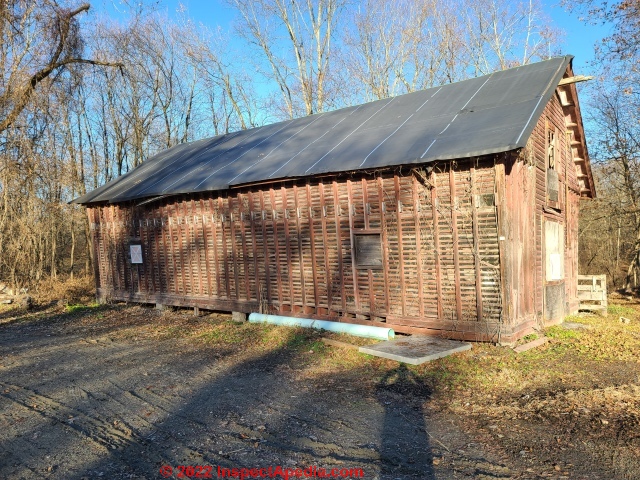
- Loamy soil
is a soil combined of clay and organic matter or humus, or more-accurately in geological terms, a soil comprised equally of sand, silt, and clay. Loamy soil is good for plants as it retains water. Loam is considered an ideal type of soil for home construction because it may be more-stable.
Some builders warn that loam that is too-high in organic materials may be unstable, requiring removal or deeper-set foundations, footings, piers or piles.
Photo below: in order to lay sod at a new home in northern Minnesota where the natural soil is hard clay, the installer spreads a layer of fine gravel then loamy soil before placing the sod.
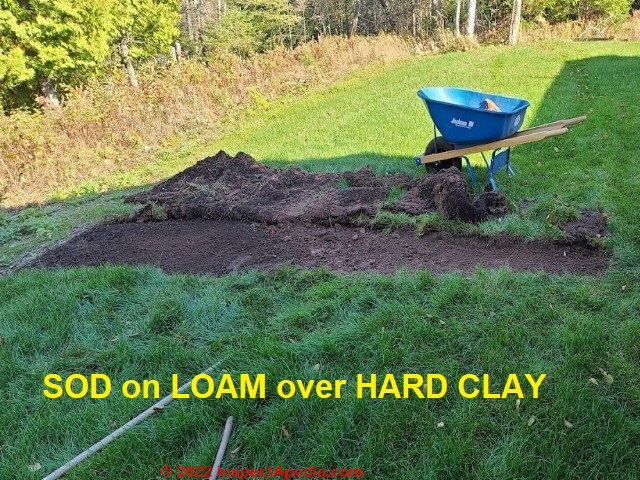
- Peat soil - organic,
such as found in wetlands or at prior bogs, is comprised principally of decayed or decaying organic matter. Peat is usually dark colored and in most climates it is high in water content.
The water level in peat may vary significantly by season. Peat may also release methane gas during some seasons.
Peat soil is a very unstable base upon which to construct a building. Peat-soil removal and replacement with engineered fill, deep piles or other special construction methods are needed.
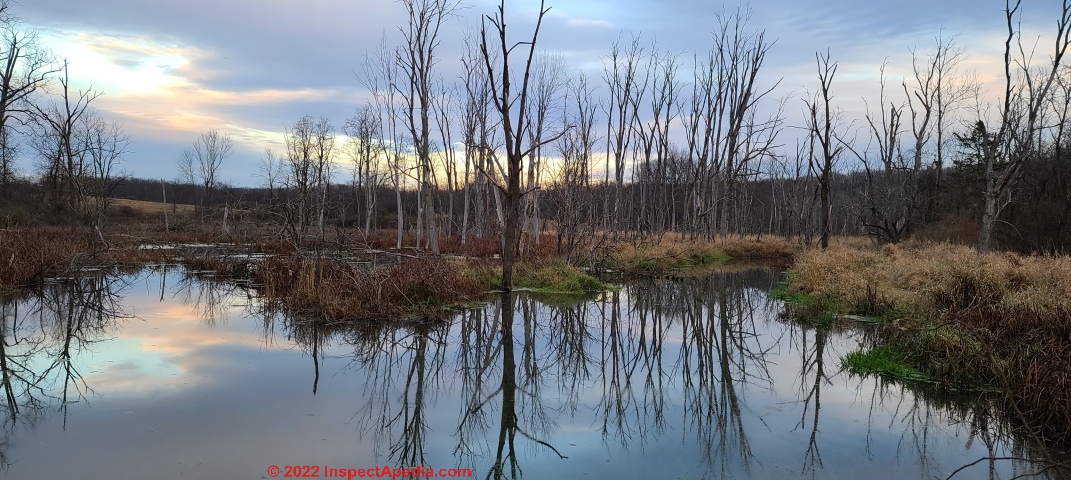
Photo above: wetlands and bogs like this conservation area on the Vassar College farm may be home to beavers but would be a costly construction site.
- Rocky soil
is comprised of a mixture of earth and stone or rock, often stable, serving very well to support a building, but possibly requiring additional fill for the construction of septic drainfields.
Some texts refer to this soil type as gravel, suggesting in that case that the soil is comprised principally of small rocks. Below our photo shows the author next to a "big rock" counter-example. Not much soil, lots of rock.
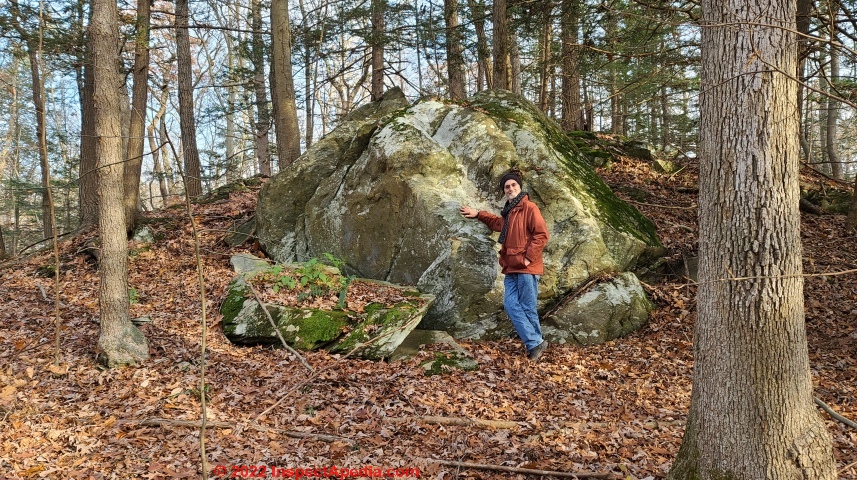
Photo above: Daniel relaxes by what looks like a few big rocks but actually this entire New York hilltop is almost entirely rock.
This would be a devil of a site on which to construct a home if excavation were required, with no chance of installing a conventional onsite septic system.
Rocky or gravel "soil" is highly variable in rock or gravel size, roughness, and stability. It does not retain moisture (unless at water's edge such as our photo below). Gravel or loose rock soil may be mixed with sand or clay but in both cases is likely to be unstable as a construction base.
Photo below: Daniel Ramirez walks along a gully in very dry, rocky soil near Jalpa, Guanajuato, Mexico.

Conversely a mixture of loam and large rocks or a site that has bedrock close to the surface may provide a stable base for construction. But there are more considerations:
Construction on sloped bedrock is likely to involve extra steps to pin the building's foundation footings to the rock to avoid later movement.
Soil that is thin over solid bedrock may translate into extra construction costs if it is necessary to remove rock to build a basement or crawl area under a structure - a design to be avoided.
Where the bedrock is sloped we often find persistent water entry problems unless the builder does a superb job of sealing the foundation and footings and the owner maintains the building roof drainage to assure that roof and surface runoff are directed away from the up-rock-slope side of the foundation.
Photo below: rocky-sandy soil below this building in Maine, plus the body of water makes the need for construction on piers rather obvious.
- Sandy or gravelly soil
is comprised of sand (ground-down granite, limestone, or perhaps quartz) with little organic or other matter.
Sandy soil is coarse, "gritty", easy to excavate and drains well, dries out quickly, but is generally unstable during excavation and unstable as a foundation base unless the sand is compacted with a mix of other soils under the building.

Photo above: J Church walking on a beach of pure sand at the Southern shore of Lake Superior, along Rte. 28 near Au Train, Michigan.
A conventional structure built on sand without deep piers or pilings or other special construction methods is likely to be unstable and risks serious damage.
Sandy soils are also easily eroded, and control of water entry into basements or crawl areas can be difficult.
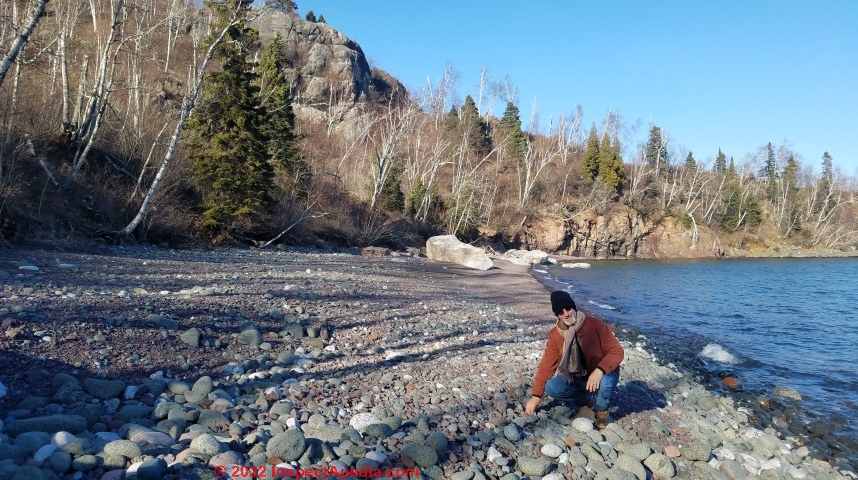
And for contrast we include a photo of the author on the rocky North shore of Lake Superior, north of Two Harbors Minnesota.
Photo below: Loose sandy soil where sidewalks were being constructed in Christchurch, New Zealand in 2014 requires special stabilizing forms before concrete is placed.
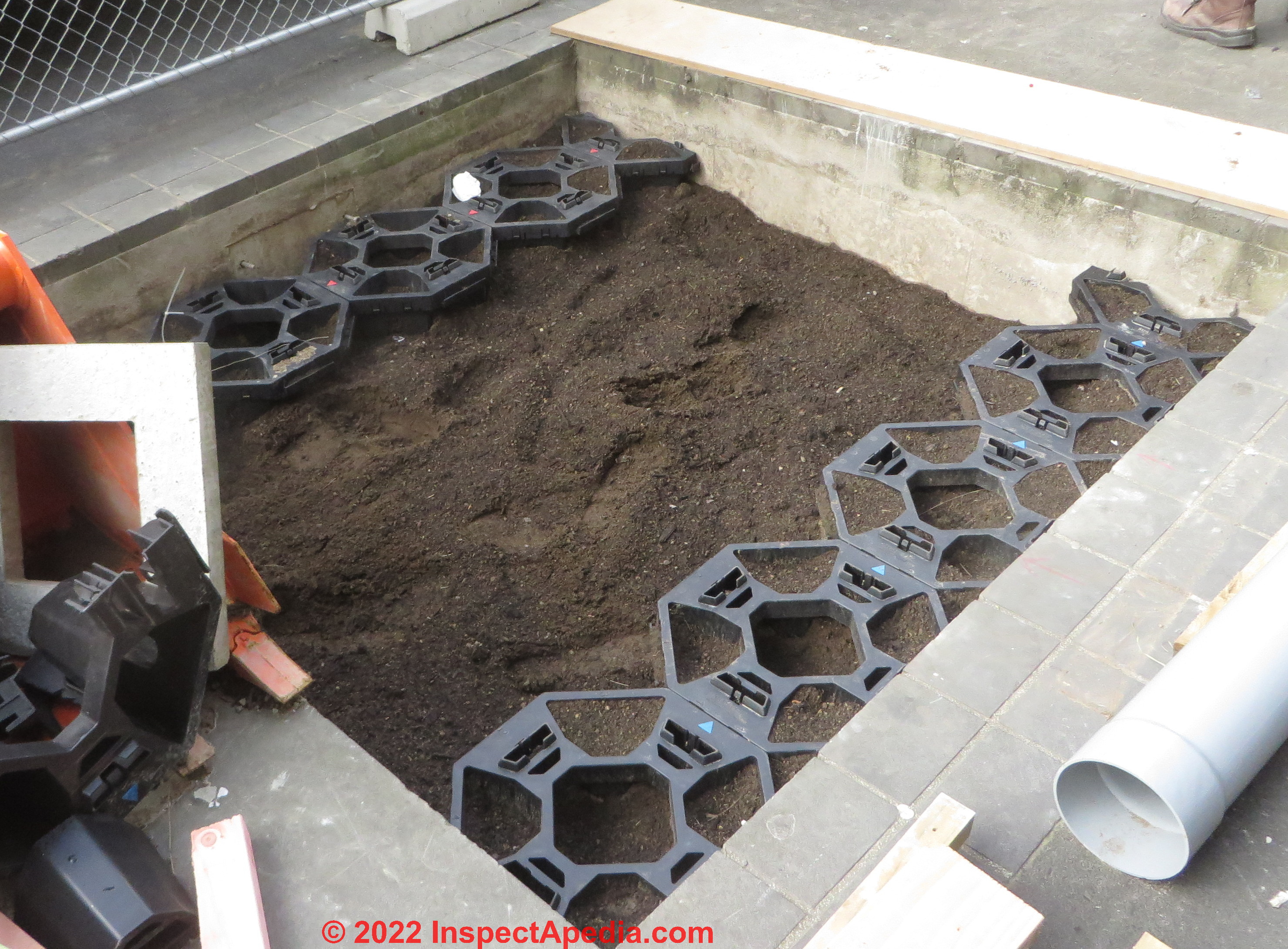
- Silty soil
is found where there are or were bodies of water and is a mixture of rock, sand and other minerals, usually comprised of fine particles, though not as fine as clay.
Silty soil will feel smooth, some sources even say "soapy". Depending on its composition, silty soil may act like clay, or quite differently, like sand except that it retains moisture more than sand.
Silt, like peat, is an unstable base on which to construct a building. Foundations built on silt will involve extra expense to provide deep piles or other special methods to avoid heaving or settlement as moisture level varies. Silty soil usually does not drain well.
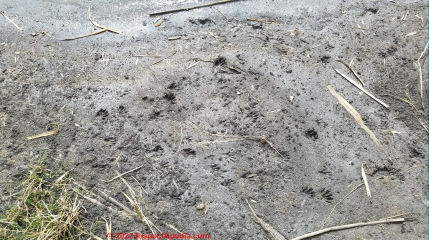
Photo above: silty soil and animal tracks, at the Charco del Ingenio, Jardin Botanico, San Miguel de Allende, Guanajuato, Mexico in 2020.
Soil moisture, which of course may vary seasonally, affects the properties of the soil, varying by the sandy versus clay or loam property of the soil.
Watch out: in low areas of wet soils, the range of building damage and damage to mechanical systems can be extensive.
See FOUNDATION DAMAGED, by FLOODING
See SEPTIC TANKS FLOATING UP
...
Types of Soils & Their Effects on Structures
Our sketch at above left provided courtesy of Carson Dunlop Associates, a Toronto home inspection, education and report-writing tool company, illustrates differences in the bearing strength of soils.
The "soil type" can affect the foundation of chimneys, buildings, structural slabs, & supporting piers or posts. By "soil type" as used in this article, we mean a very-simplified classification of soils as they affect construction of buildings, wells and septic systems, such as sandy soil, expansive clay, rocky soil, solid rock or bedrock.
The ideal soil for building construction is one that remains stable through both wet and dry weather, has good bearing strength to carry the weight of the building constructed upon it, and remains in place and stable in wet weather resisting erosion.
Sinkholes & Smaller Soil Subsidences
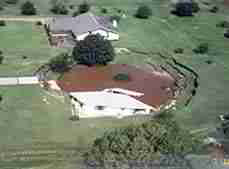 If you live in an area where sinkholes are common, such as parts of Florida in the U.S., a discussion of sinkhole risks would be mandatory lest you build a home that later disappears into a giant hole.
If you live in an area where sinkholes are common, such as parts of Florida in the U.S., a discussion of sinkhole risks would be mandatory lest you build a home that later disappears into a giant hole.
See those details at SINKHOLES, WARNING SIGNS
When an expert such as a geotechnical engineer uses the term "sinkhole" s/he refers to generally large soil subsidences caused by the events described in our SINKHOLES articles linked above and just below.
Readers concerned about soil subsidence or sinkholes should
see SINKHOLES - IMMEDIATE SAFETY ACTIONS.
But in more popular speech among homeowners, attorneys, and contractors, smaller site subsidences may also be referred to as "sinkholes" and may be caused by events such as collapsing soils or smaller sized but still dangerous sinkholes over other site features such as:
An abandoned buried oil storage tank - See details
at OIL TANK ABANDONING PROCEDURE
A septic tank, cesspool or drywell - abandoned or in-use - see important safety warnings
Construction on Backfill
Photo: the concrete block chimney is buckling and collapsing. The building inspector found that the chimney was built without an adequate footing for the soil type on which the chimney rests. As the thin shallow footing settled and tipped the chimney was damaged.
Because this chimney was built against the wall of a home with a basement, and because the chimney's "footing" was just a foot or so below ground whereas the basement floor was a good six feet below grade level, it's pretty obvious that the chimney's footing was placed atop simple undocumented "backfill" - soil pushed back against the building's foundation after that had been constructed.
The result was a settling, tipping chimney footing and a cracked damaged masonry chimney.
Watch out: any movement in a masonry chimney risks making it unsafe, risking a building fire, carbon monoxide poisoning, or in extreme cases also a chimney collapse.
Details are at CHIMNEY MOVEMENT, ONGOING vs STATIC
...
Soil Questions When Buying Land or an Existing Home
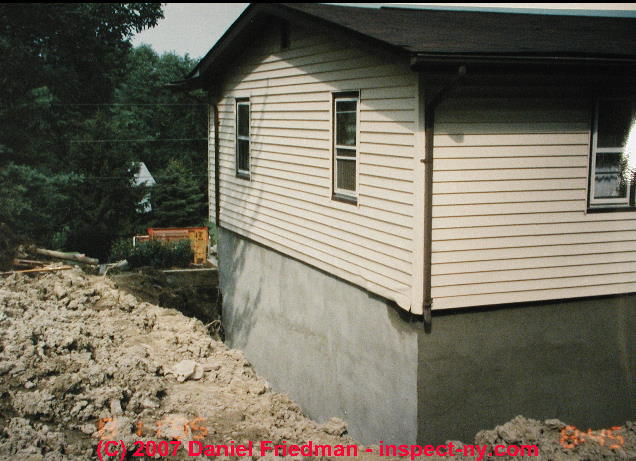 Photo: this home's foundation had to be completely re-built after a combination of water, frost, and soil pressure collapsed its concrete block foundation. Note how the home sits in hole.
Photo: this home's foundation had to be completely re-built after a combination of water, frost, and soil pressure collapsed its concrete block foundation. Note how the home sits in hole.
Backfill around the foundation will be less compact: water can still be trapped around the house if roof and surface drainage are not handled properly.
- Is there fill of any type on the property?
Beware of construction on fill, backfill, or buried debris & tree stumps left behind when clearing land. Buried debris may include trees, branches, and tree stumps, rocks, broken up concrete, collapsed building structures, and more.
Watch out: in an example of undocumented fill, a home builder in northern Minnesota described looking at the four remaining lots for sale in a housing development with a prospective homeowner.
He explained that one of the problems with these last available lots was that they had become the dumping ground for all the other lots where construction had already occurred.
As work had been done on the surrounding new homes, debris, tree stumps, and rock, from those projects had been left on these adjacent lots.
The cost of remediating this lot as part of the necessary soil correction and site preparation would be significant, over and above the cost of the lot or the construction of the home.
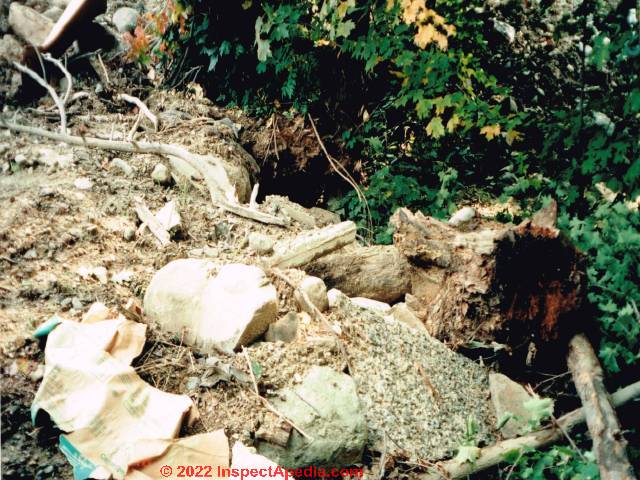
Photos above and below: un-documented fill at a construction site can spell trouble for the building or for a septic drainfield as a builder may use the site as a trash dump.
This site included plastic joint compound buckets, chunks of concrete, tree stumps and wood debris.
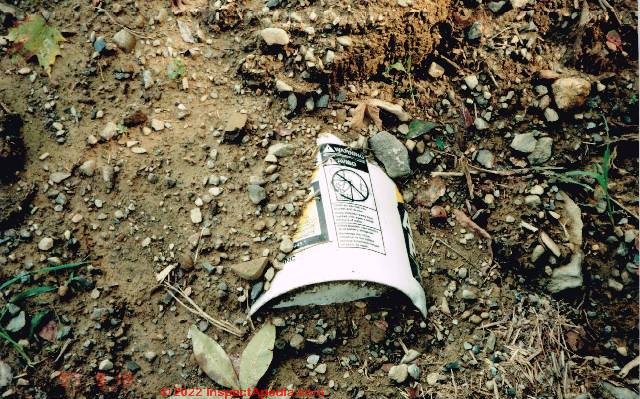
Watch out: non-engineered or undocumented fill at a property could also contain environmental contaminants and pose significant remediation costs. - What soil types are at the property
and how will those affect construction of a building or other site features like a septic system?
Beware of planning to build on bogs, peat, sand. - What is the grade or slope of the property
and how will these affect drainage, surface runoff, or the need for fill when building? - Is there bedrock
that will affect construction at the site? - If the property will include an onsite septic system,
what is the soil type and its perc-rate? Soil perc tests determine type & size & thus cost of onsite wastewater disposal: septic systems.
Also see SITE FACTORS AFFECTING FOUNDATIONS
...
Effects of Soil Types on Building Water Entry
- Site work,
site preparation, soil type, grade affect water movement direction.
Watch out: backfill or other fill at a property that is compacted less than the original soil can result in un-anticipated water movement around or towards a building or a septic drainfield because water moves more easily through un compacted fill than through original virgin undisturbed soil - varying by soil type.
Backfill may be more porous than original grade and can trap water against a foundation.
See also GRADING, DRAINAGE & SITE WORK - home - Sandy soils
water moves easily: drains well but may drain towards a foundation. Sandy soils are easily eroded unless erosion control measures are taken.
Photo below: an erosion control system in central Mexico in an area of sloped, sandy soils.
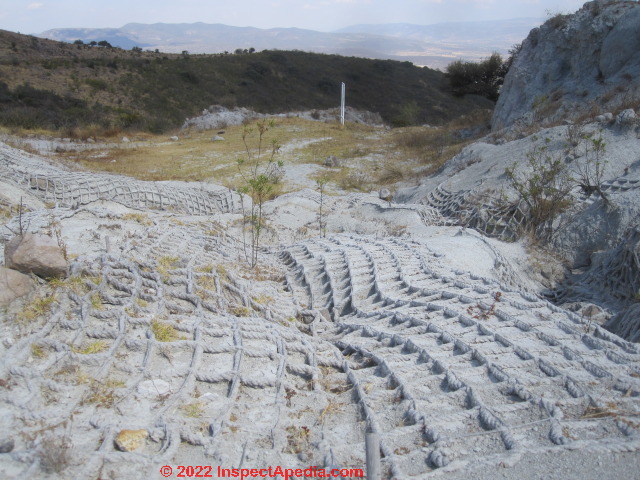
- Clay soils
its impervious nature means clay soil can serve as a water block - not transmitting water underground, but also, where a basement or crawl space has been excavated in clay soil, water from surface or roof runoff near the building will be trapped against foundation, inviting water entry.
Also, water infiltration through clay soil or other soils containing fines (extremely small soil particles) clogs footing drains.
Geotechnical definition: soil "fines" are particles defined as particles that are smaller than 0.075mm, 0.00295 in, or 200 sieve in size.

Photo above: soil with a high percentage of silt or fines will infiltrate and clog building footing drains if sufficient geotextile protection is not provided during footing drain construction. - Sloping rock
sends water towards one side of a foundation or blasted rock can trap water around a foundation.
Photo below: large sloped rock or sloping bedrock can trap surface and subsurface runoff against a building foundation wall.

...
Effects of Soil Type on Septic Systems
Standard procedure for anyone buying property to be served by an onsite waste disposal system: a septic tank and drainfield or absorption bed, is to perform soil perc tests to determine the rate at which the soil can accept wastewater.
The image below illustrates a test pit dug to permit performing a soil percolation test or "perc test". The stepped side of the pit is recommended for deep test pits like the one shown, so that the test technician or engineer can safely enter and exit the pit to make necessary test water depth measurements.
Along with the anticipated wastewater load, the results of the perc test tell us the required septic drainfield size and thus effect the cost of the septic system.
See details at SEPTIC SOIL & PERC TESTS
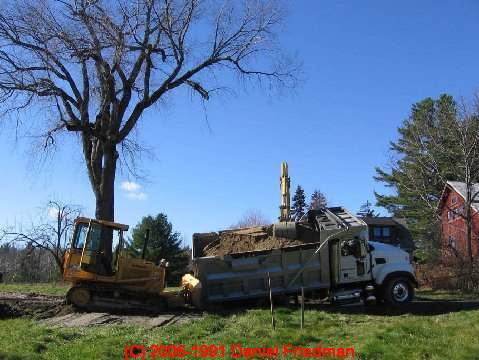 Clay soil:
Clay soil:
has such poor percolation rate that the cost of installing a conventional septic system will increase by the need to build a mound system or to construct a drainfield with a larger footprint to properly handle the anticipated wastewater volume.
Rocky soil:
may require bringing in additional fill or if there is very thin soil coverage, the construction of a raised-bed septic or a septic mound system.
Sandy soil:
may easily dispose of clarified effluent leaving the septic tank, but may fail to support enough bacteria to process pathogens in the septic wastewater. The result: good disposal, but risk of inadequate treatment, contamination of nearby wells or waterways.
Photo: the contractor's dump truck drove over an abandoned septic tank or seepage pit, collapsing and falling part-way into the pit. The bulldozer was called to help dig and push out the trapped truck.
Details are
at DRIVING or PARKING OVER SEPTIC
Also see SEWER / SEPTIC LINES at STEEP SITES
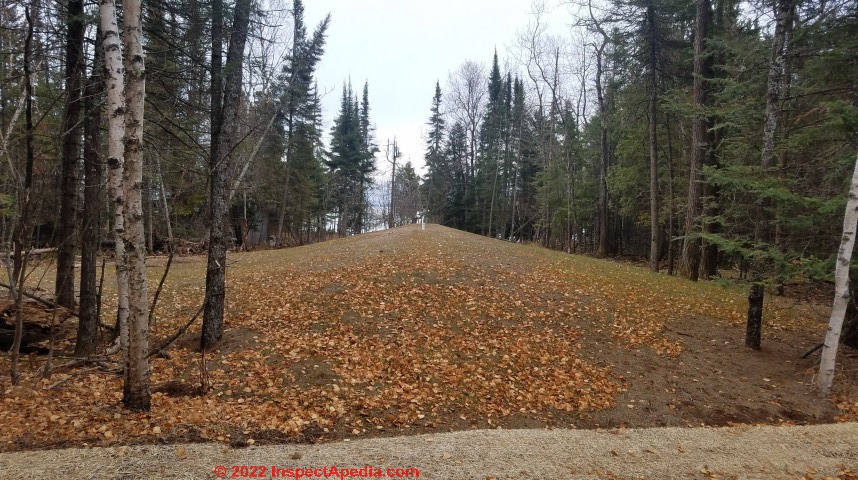
Photo above: because the native soil was principally rock and poorly-drained, the construction of a septic system at this northern Minnesota home required bringing-in fill to construct a mound type septic system.
...
Effects of Soil Type on Water Well Construction & Maintenance
Clay soils:
easy to seal the well casing against surface water contamination of the well, provided the well bore is properly sealed around the outside of the well casing during well construction.
Rocky soils
and solid rock may increase the cost of installing a drilled well. Bedrock deeper in the soil may direct subsurface contaminants to a well.
Sandy soils:
watch out for surface water runoff or surface contaminants that find an easy passage into a drilled well.
Watch out also for collapse of wells during drilling or hand-digging in sandy or other unstable soils.
Effect of Land Slope on Building Construction
Constructing on a slope can translate into extra costs to bring in fill at the down-slope end of a building or for the construction of an onsite septic system.
Watch out: a common foundation crack problem or footing settlement problem we encounter in home inspections is footing settlement and foundation wall cracking at the point of transition between footing built on original, un-disturbed soil and the continuation of the building's footing that was constructed on poorly compacted fill.
...
12 Soil Taxonomic Orders
Technically More Complete Types of Soil
Soil experts, including those in the U.S. at the USDA/NRCS, use a far more technically complete and taxing classification system for soil types of which there are a dozen taxonomic orders that are used on the USDA/NRCS soil map shown above:
Entisols, Inceptisols, Andisols, Mollisols, Alfisols, Spodosols, Ultisols, Oxisols, Gelisols, Histosols, Aridisols, and Vertisols.
The classification of soils into these groups supports many uses and is not specifically focused on building construction. We define each of these soil taxa in the references section at the end of this page.
And there is a scientific overlap: local builders may refer to constructing on expansive clay soil that must be kept wet to avoid shrinkage and foundation damage, while a soil taxonomist might call the same soil a vertisol.
Watch out: if you ask your building or septic contractor about any soil type between Entisols and Vertisols you'll probably see her quietly turn away, get back into her truck, and drive away, as you've marked yourself as a troublesome and annoying customer.
On the other hand, it's perfectly correct, easy, and reasonable to discuss general soil properties that will affect construction such as sandy, rocky, clay, or poorly drained soils both when planning new construction and when diagnosing and fixing building foundation or footing failures such as settlement or ongoing movement.
...
Research on Soil Properties & Impact on Structures & Mechanical Systems

Photo: supporting soil properties surely explain the leaning tower of Pisa - photo courtesy of Tom Smith & Daniel Friedman.
- Abbaszadeh, Mohammad. The effect of cracks on unsaturated flow and volume change properties of expansive clays and impacts on foundation performance. Arizona State University, 2011.
- Basha, Ali, and Mohammed Elsiragy. "Effect of sheet pile driving on geotechnical behavior of adjacent building in sand: numerical study." Civil Engineering Journal 5, no. 8 (2019): 1726-1737.
- Bajaj, Ketan, Jitesh T. Chavda, and Bhavik M. Vyas. SEISMIC BEHAVIOUR OF BUILDINGS ON DIFFERENT TYPES OF
SOIL [PDF] In Proceedings of Indian Geotechnical Conference. 2013.
Abstract:
Buildings are subjected to different earthquake loading and behaves differently with diversification in the types of soil condition, such as dense soil, medium and soft soil.
Different soil properties can affect seismic waves as they pass through a soil layer. When a structure is subjected to an earthquake excitation, it interacts with the foundation and soil, and thus changes the motion of the ground.
It means that the movement of the whole ground structure system is influenced by type of soil as well as by the type of structure. As the seismic waves transfer from the ground which consist of alteration in soil properties and performs differently according to soil’s respective properties.
In this study, different soil strata are taken and corresponding base shear and lateral displacement is determined with variation in floors as G+4, G+5 and G+6 and zone as 3, 4 and 5. IS 1893: 2002 “Criteria for Earthquake Resistant Design of Structures” gives response spectrum for different types of soil such as hard, medium and soft.
A building is modeled in SAP-2000 having different Winkler’s springs as its foundation corresponding to different soil properties.
This research has immense benefits in the Geotechnical Earthquake engineering field. - DEFRA, CONSTRUCTION CODE OF PRACTICE FOR THE SUSTAINABLE USE OF SOILS ON CONSTRUCTION SITES [PDF] (2009) Department for Environment, Food, and Rural Affairs, Defra
Soils Policy Team
3C Nobel House
London SW1P 3JR
Telephone: 020 7238 6419
Website: www.defra.gov.uk
This document is also available on the Defra website.
http://defraweb/environment/land/soil/index.htm
Published by the Department for Environment, Food and Rural Affairs.
Summary excerpt:
Soil is a fundamental and ultimately finite resource that fulfils a number of functions and services for society which are central to sustainability. Some of the most significant impacts on this resource occur as a result of activities associated with construction activity, yet it appears that there is a general lack of awareness and understanding of this need within the construction industry.
A Code of Practice has therefore been developed to assist anyone involved in the construction sector to better protect the soil resources with which they work. By following the guidance in the Code you will not only be able to help protect and enhance the soil resources on site but you may also achieve cost savings for your business. - GeoSolv, "Soil and Foundation Challenges" [Web Article], GeoSolv, Design/Build, Inc., 120 Vinyl Court, 2nd Floor Woodbridge, Ontario L4L 4A3 Phone: 905-266-2599 Fax: 905-266-2601 www.geosolv.ca solutions@geosolv.ca - retrieved 2022/02/10 original source: https://geosolv.ca/soil-types/
- Hassan, Amer, and Shilpa Pal. "Effect of soil condition on seismic response of isolated base buildings." International Journal of Advanced Structural Engineering 10, no. 3 (2018): 249-261.
- Jennings, Paul C., and Jacobo Bielak. "Dynamics of building-soil interaction." Bulletin of the Seismological Society of America 63, no. 1 (1973): 9-48.
Abstract
In this study of the dynamics of building-soil interaction, the soil is modeled by a linear elastic half-space, and the building structure by an n-degree-of-freedom oscillator. Both earthquake response and steady-state response to sinusoidal excitation are examined.
By assuming that the interaction system possesses n+2 significant resonant frequencies, the response of the system is reduced to the superposition of the responses of damped linear oscillators subjected to modified excitations.
The results are valid even though the interaction systems do not possess classical normal modes. For the special cases of single-story systems and the first modes of n-story systems, simplified approximate formulas are developed for the modified natural frequency and damping ratio and for the modified excitation.
Example calculations are carried out by the approximate and more exact analysis for one-story, two-story and ten-story interaction systems.
The results show that interaction tends to decrease all resonant frequencies, but that the effects are often significant only for the fundamental mode for many n-story structures and are more pronounced for rocking than for translation.
If the fixed-base structure has damping, the effects of interaction on the earthquake responses are not always conservative, and an increase or decrease in the response can occur, depending on the parameters of the system. - Lakshmikantha, M. R., Pere C. Prat, and Alberto Ledesma. "Experimental evidence of size effect in soil cracking." Canadian Geotechnical Journal 49, no. 3 (2012): 264-284.
- Matanovic, Davorin, Marin Cikes, and Bojan Moslavac. Sand control in well construction and operation. Springer Science & Business Media, 2012.
Photo abovee\: undocumented "fill" at a roadwork excavation in Duluth, Minnesota.
- Nakhaei, Mofid, and Mohammad Ali Ghannad. "The effect of soil–structure interaction on damage index of buildings." Engineering Structures 30, no. 6 (2008): 1491-1499.
Abstract excerpt:
The effect of Soil–Structure Interaction (SSI) on Park and Ang Damage Index in a Bilinear-SDOF model is investigated under seismic loading. - Orense, Rolando, Naoaki Suemasa, and Yasin Mirjafari. SOIL TYPE IDENTIFICATION AND FINES CONTENT ESTIMATION USING THE SCREW DRIVING SOUNDING (SDS) DATA [PDF] Proc. 20th NZGS Geotechnical Symposium. Eds. GJ Alexander & CY Chin, Napier
Abstract:
Identification of ground conditions is a very important step before starting to build any geotechnical structure. Geotechnical investigations are performed to determine the soils conditions and to evaluate the cost-effectiveness and design of a proposed engineering construction. Fines contents (FC) in sandy soils also play an important role in the engineering design of geotechnical structures, particularly in areas prone to earthquakes.
The Screw Driving Sounding (SDS) is a new in-situ test in which a machine drills a screw point into the ground in several loading steps while the attached rod is continuously rotated. At the same time, a number of parameters, such as torque, load and speed of penetration are logged at every rotation of the rod. Because this machine can continuously measure these parameters, an interpreted overview of the soil profile throughout the depth of penetration can be obtained. In this study, a large number of tests were conducted adjacent to boreholes in New Zealand.
An attempt was made to correlate the SDS parameters to the soil type as described in the boring logs. In addition, samples from several SDS sites were obtained and sieve analyses were performed in order to formulate a relationship between the fines content and the SDS parameters. From the results, charts were developed to show how soil can be classified and fines content can be estimated using the SDS data. As a simple, fast and economical test, the SDS method can be a reliable alternative in-situ test for soil characterisation. - Priyanka, RM Jenifer, N. Anand, and Dr S. Justin. STUDIES ON SOIL STRUCTURE INTERACTION OF MULTI STOREYED BUILDINGS WITH RIGID AND FLEXIBLE FOUNDATION [PDF] International Journal of Emerging Technology and Advanced Engineering 2, no. 12 (2012): 111-118.
Abstract
Though the structures are supported on soil, most of the designers do not consider the soil structure interaction and its subsequent effect on structure during an earthquake. Different soil properties can affect seismic waves as they pass through a soil layer.
When a structure is subjected to an earthquake excitation, it interacts the foundation and soil, and thus changes the motion of the ground. It means that the movement of the whole ground structure system is influenced by type of soil as well as by the type of structure.
Tall buildings are supposed to be of engineered construction in sense that they might have been analyzed and designed to meet the provision of relevant codes of practice and building bye-laws. IS 1893: 2002 “Criteria for Earthquake Resistant Design of Structures” gives response spectrum for different types of soil such as hard, medium and soft.
An attempt has been made in this paper to study the effect of Soil-structure interaction on multi storeyed buildings with various foundation systems. Also to study the response of buildings subjected to seismic forces with Rigid and Flexible foundations.
Multi storeyed buildings with fixed and flexible support subjected to seismic forces were analyzed under different soil conditions like hard, medium and soft.
The buildings were analyzed by Response spectrum method using software STAAD Pro. The response of building frames such as Lateral deflection, Storey drift, Base shear, Axial force and Column moment values for all building frames were presented in this paper. Keywords— Base shear, Fixed base, Flexible base, Soil stiffness, Storey drift ... - USDA, Soil Survey Staff. 2015. ILLUSTRATED GUIDE to SOIL TAXONOMY [PDF] U.S. Department of Agriculture, Natural Resources Conservation Service, National Soil Survey Center, Lincoln, Nebraska.
Excerpt from Foreword:
The “Illustrated Guide to Soil Taxonomy” is intended for use by multiple audiences.
First, it is designed to help college students who have some background in soil science, and especially those participating on collegiate soil judging teams, to learn the fundamental concepts of soil classification.
Second, it is for professionals who use soil survey information in their work, such as soil conservationists, agronomists, rangeland specialists, foresters, and engineers.
The narrative descriptions for the soil orders, suborders, and great groups can help them to understand the broad concepts of soil classification. In addition, definitions of many of the diagnostic horizons and features are accompanied by photos and background information.
This can help the professional to understand the importance of these horizons and features and how they relate to their work. Third, the guide is for soil scientists beginning a career in soil survey. Its presentation of basic concepts will be helpful in their work, especially as they encounter new kinds of soil taxa.
Alfisol – soils with aluminum and iron. They have horizons of clay accumulation, and form where there is enough moisture and warmth for at least three months of plant growth. They constitute 10% of soils worldwide.
Andisol – volcanic ash soils. They are young and very fertile. They cover 1% of the world's ice-free surface.
Aridisol – dry soils forming under desert conditions which have fewer than 90 consecutive days of moisture during the growing season and are nonleached. They include nearly 12% of soils on Earth. Soil formation is slow, and accumulated organic matter is scarce. They may have subsurface zones of caliche or duripan. Many aridisols have well-developed Bt horizons showing clay movement from past periods of greater moisture.
Entisol – recently formed soils that lack well-developed horizons. Commonly found on unconsolidated river and beach sediments of sand and clay or volcanic ash, some have an A horizon on top of bedrock. They are 18% of soils worldwide.
Gelisol – permafrost soils with permafrost within two metres of the surface or gelic materials and permafrost within one metre. They constitute 9% of soils worldwide.
Histosol – organic soils, formerly called bog soils, are 1% of soils worldwide.
Inceptisol – young soils. They have subsurface horizon formation but show little eluviation and illuviation. They constitute 15% of soils worldwide.
Mollisol – soft, deep, dark fertile soil formed in grasslands and some hardwood forests with very thick A horizons. They are 7% of soils worldwide.
Oxisol – are heavily weathered, are rich in iron and aluminum oxides (sesquioxides) or kaolin but low in silica. They have only trace nutrients due to heavy tropical rainfall and high temperatures and low CEC of the remaining clays. They are 8% of soils worldwide.
Spodosol – acid soils with organic colloid layer complexed with iron and aluminium leached from a layer above. They are typical soils of coniferous and deciduous forests in cooler climates. They constitute 4% of soils worldwide.
Ultisol – acid soils in the humid tropics and subtropics, which are depleted in calcium, magnesium and potassium (important plant nutrients). They are highly weathered, but not as weathered as Oxisols. They make up 8% of the soil worldwide.
Vertisol – inverted soils. They are clay-rich and tend to swell when wet and shrink upon drying, often forming deep cracks into which surface layers can fall. They are difficult to farm or to construct roads and buildings due to their high expansion rate. They constitute 2% of soils worldwide.
Soil Moisture Regimes
Many of the suborders and some great groups are defined by the moisture regime of the soil. The soil moisture regimes are defined by conditions within the moisture control section (MCS).The upper boundary of the MCS is the depth to which a dry soil will be wetted by 2.5 cm of precipitation in a 24-hour period.
The lower boundary is the depth to which the same soil will be wetted by 7.5 cm of precipitation in a 48-hour period. Note that the MCS will vary depending on the porosity of the soil. As a general rule, the MCS will begin and end deeper in the profile as texture becomes progressively coarser, as follows:
Depth is 10-30 cm if the soil is loamy or clayey.
Depth is 20-60 cm if the soil is loamy with < ~18% clay and > ~15% sand.
Depth is 30-90 cm if the soil is sandy.
(Depth may be even greater for gravelly soils.) - USDA, SOIL TAXONOMY, A Basic System of Soil Classification for
Making and Interpreting Soil Surveys [PDF] (1999) United States Department of Agriculture, Natural Resources Conservation Service (NRCS), retrieved 2022/02/09 original source: https://www.nrcs.usda.gov/Internet/FSE_DOCUMENTS/nrcs142p2_051232.pdf
NRCS Distribution Center Enter keywords: soil taxonomy 2nd edition Phone toll free: 1-888-526-3227 E-mail: NRCSDistributionCenter@ia.usda.gov
Excerpt:
About 1870, a new concept of soil was introduced by the Russian school led by Dokuchaiev (Glinka, 1927). Soils were conceived to be independent natural bodies, each with a unique morphology resulting from a unique combination of climate, living matter, earthy parent materials, relief, and age of landforms.
The morphology of each soil, as expressed by a vertical section through the differing horizons, reflects the combined effects of the particular set of genetic factors responsible for its development.
...
Continue reading at SINKING BUILDINGS, or select a topic from the closely-related articles below, or see the complete ARTICLE INDEX.
Or see these
Recommended Articles
- BUILDING SETTLEMENT
- DIAGONAL CRACKS in BLOCK FOUNDATIONS, WALLS
- FOUNDATION CRACKS & DAMAGE GUIDE - home
- FOUNDATION FAILURES in CLAY SOIL
- FOUNDATION SETTLEMENT
- GRADING, DRAINAGE & SITE WORK
- RETAINING WALL DESIGNS, TYPES, DAMAGE - home
- SEPTIC FAILURE SIGNS
- SETTLEMENT CRACKS in SLABS
- SINKHOLES & SUBSIDENCES - home
- SINKING BUILDINGS
- SITE FACTORS AFFECTING FOUNDATIONS
- SLAB CRACK EVALUATION
- VERTICAL CRACKS in BLOCK WALLS
- WATER ENTRY in BUILDINGS
Suggested citation for this web page
SOIL PROPERTIES & BUILDING FAILURES at InspectApedia.com - online encyclopedia of building & environmental inspection, testing, diagnosis, repair, & problem prevention advice.
Or see this
INDEX to RELATED ARTICLES: ARTICLE INDEX to BUILDING STRUCTURES
Or use the SEARCH BOX found below to Ask a Question or Search InspectApedia
Ask a Question or Search InspectApedia
Try the search box just below, or if you prefer, post a question or comment in the Comments box below and we will respond promptly.
Search the InspectApedia website
Note: appearance of your Comment below may be delayed: if your comment contains an image, photograph, web link, or text that looks to the software as if it might be a web link, your posting will appear after it has been approved by a moderator. Apologies for the delay.
Only one image can be added per comment but you can post as many comments, and therefore images, as you like.
You will not receive a notification when a response to your question has been posted.
Please bookmark this page to make it easy for you to check back for our response.
IF above you see "Comment Form is loading comments..." then COMMENT BOX - countable.ca / bawkbox.com IS NOT WORKING.
In any case you are welcome to send an email directly to us at InspectApedia.com at editor@inspectApedia.com
We'll reply to you directly. Please help us help you by noting, in your email, the URL of the InspectApedia page where you wanted to comment.
Citations & References
In addition to any citations in the article above, a full list is available on request.
- In addition to citations & references found in this article, see the research citations given at the end of the related articles found at our suggested
CONTINUE READING or RECOMMENDED ARTICLES.
- Carson, Dunlop & Associates Ltd., 120 Carlton Street Suite 407, Toronto ON M5A 4K2. Tel: (416) 964-9415 1-800-268-7070 Email: info@carsondunlop.com. Alan Carson is a past president of ASHI, the American Society of Home Inspectors.
Thanks to Alan Carson and Bob Dunlop, for permission for InspectAPedia to use text excerpts from The HOME REFERENCE BOOK - the Encyclopedia of Homes and to use illustrations from The ILLUSTRATED HOME .
Carson Dunlop Associates provides extensive home inspection education and report writing material. In gratitude we provide links to tsome Carson Dunlop Associates products and services.



